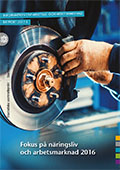
Family-owned enterprises account for more than a third of Sweden’s GDP, and one in three employees work for a family-owned enterprise. Family-owned enterprises are diverse and consist of both small producers and large multinational corporations. In addition, they are active in all areas of the business sector. These are the findings of a study published in the periodical Focus on Business and Labour Market.
In the first article, domestically controlled family enterprises are identified using several databases at Statistics Sweden, including one listing entrepreneurs. The use of several databases provides a unique opportunity to analyse the importance of these enterprises to the Swedish economy.
The economic development of the automotive industry
The second article provides an overview of the economic development of the automotive industry in Sweden. The contribution of this important industry to the Swedish economy in the 1990s and 2000s is highlighted. Employment, wage costs, and production in the industry are analysed. An analysis using input-out methodology is applied and shows that each new job in the automotive industry generates another job in a different sector of the Swedish economy.
The impact of unemployment on future earnings
The third article examines the long-term effects of unemployment on future earnings by studying white-collar workers who experienced a period of unemployment between 2007 and 2010. The analysis reveals that a period of unemployment has a negative effect on future earnings. The results show that a period of unemployment leads to a decrease in future earnings by almost 20 percent compared with a similar group of white-collar employees who did not experience unemployment during the same period. White-collar workers who faced the largest drop in income in the short term were those who were older, had relatively low income, and who worked in professions that required a high level of qualification.
An approach to separating categories of R&D activities
The final article is an attempt to distinguish different categories of research and development (R&D) activities. The current set-up of the statistics makes it difficult to separate R&D activities into the categories information and communication technology (ICT) and life science. The occupational structure of enterprises is used to test an algorithm that separates different categories of R&D activities.
Source: www.scb.se/en
Graphics: Statistics Sweden



 EUR 4.2515 zł
EUR 4.2515 zł USD 3.6108 zł
USD 3.6108 zł DKK 0.5698 zł
DKK 0.5698 zł SEK 0.378 zł
SEK 0.378 zł NOK 0.3582 zł
NOK 0.3582 zł